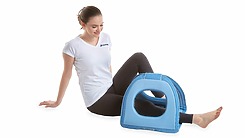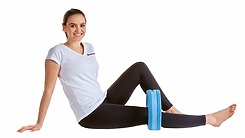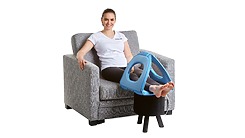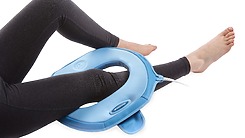Biomag - Encyclopedia - Osteoarthritis of the knee
Osteoarthritis of the knee - symptoms, description and treatment

Author MUDr. Peter Bednarčík CSc.
Revision
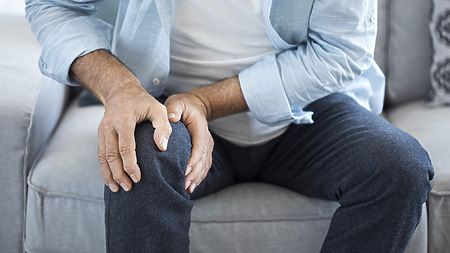
When you get up in the morning, does every step feel like your knees are full of broken glass? Osteoarthritis of the knee may be the cause. For millions of people around the world, this pain is not just a temporary discomfort, but a constant companion. Although often considered an inevitable part of ageing, knee osteoarthritis knows no age limits and can affect even the most active individuals.
Find out what the causes are and what treatment options exist for knee osteoarthritis. How can you combat symptoms such as pain, swelling and inflammation that accompany this disease? Read more here.
Osteoarthritis of the knee symptoms
- Pain
- The Island
- Stiffness
- Limited range of motion in the knee
Knee osteoarthritis pain and swelling tend to be worse in the morning or after prolonged periods of sitting and resting. Sudden worsening of pain can occur after physically strenuous activity.
If the knee “jerks” during movement, patients may hear an unpleasant creaking sound caused by the surfaces rubbing together (called crepitus). The pain may be accompanied by a feeling of weakness or instability in the knee. [1]

Only a doctor can make a correct diagnosis. Do not use this or any other article on the internet to make a diagnosis. Don’t put off seeing a doctor and address your condition early.
Osteoarthritis in the knee
What is osteoarthritis of the knee ?
Knee osteoarthritis is the most common type of osteoarthrites. It inherently includes pain when walking, morning stiffness of the knee and swelling of the joint. These and other problems are far from being limited to the elderly; osteoarthritis of the knees is also common in younger people.[2]
Knee osteoarthritis (gonarthrosis of the knee) is a degenerative disease caused by wear and tear of the cartilage in the knee joint.
Damage to this protective layer, which allows smooth movement of the joint, results in unwanted and painful friction of the bones in the joint. Osteoarthritis in the knee develops gradually and over time the pain in the affected joint worsens.[3]
Prevalence and patient demographics or who is affected by osteoarthritis
The typical gonarthrosis patient is 50 years of age or older. However, knee osteoarthritis at the age of 30 is no exception.4 Statistics show that approximately 13% of women and 10% of men over the age of 60 have knee osteoarthritis and experience symptoms. The number rises to 40% for those in their seventies.[5]
Cause of osteoarthritis of the knee
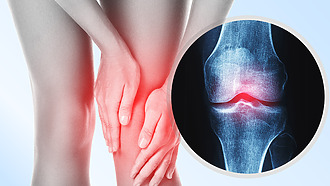
A number of factors are involved in the development of knee osteoarthritis. Age and natural wear and tear on the joints play a role. Other causes include:
- Previous knee injury ,
- physically demanding jobs,
- vigorous sports (for example, running),
- overweight(excessive weight puts a strain on the joints),
- genetic burden (family history of osteoarthritis) [6].
Being female is also considered a risk factor – osteoarthritis is more common in women regardless of age. People with diabetes, high cholesterol and vitamin D deficiency are more prone toosteoarthritis.[7]
The cause of gonarthrosis can also lie in various deformities of the knee. [8]
Diagnostics
The diagnosis of osteoarthritis of the knee is usually made on the basis of symptoms and physical examination. The degree of damage to the joint is assessed by X-rays.
The X-ray does not show the cartilage itself, but the narrowing of the joint space, which is related to the loss of cartilage, is clearly visible on the image. Magnetic resonance imaging and computed tomography are usually not necessary in knee osteoarthritis. In some cases, on the other hand, a knee puncture is performed, during which a sample of joint fluid is taken.[9]
Physical examination in the diagnosis of osteoarthritis of the knee includes:
- Palpation of the knee and assessment of pain or swelling,
- control of active and passive movement of the knee joint,
- assessment of (in)stability of the joint,
- assessment of walking style,
- listening for any “creaking” of the joint (crepitus).[10]
What is WOMAC?
A questionnaire called theWestern Ontario and McMaster Universities Arthritis Index (WOMAC) is used to assess health status with a focus on pain, joint stiffness and limitations in daily activities. In it, patients answer simple questions about the intensity of their pain or limitations in activities such as getting in the car, getting out of bed or getting dressed.[11]
Knee Osteoarthritis - Grades
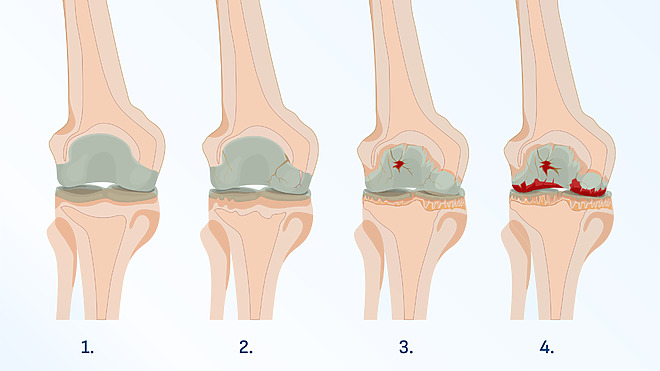
A five-step scale is used to assess the severity of knee osteoarthritis. Grades 0 – 4 clearly indicate how badly the knee joint is damaged and what is the usual procedure for that grade.
Grade 0
- Normal condition of the joint.
- There are no signs of osteoarthritis and joint function is not restricted.
Grade 1
- The knee joint shows a small loss of cartilage and may have small bony growths.
- In 1st stage of osteoarthritis, patients usually have no pain and no treatment is needed. However, doctors recommend starting with exercise to slow the progression of osteoarthritis.
Grade 2
- Arthritis of the knee of the second degree is considered a mild stage of the disease.
- X-ray examination shows increasing bone growths, but the size of the cartilage is still sufficient.
- The individual parts of the joint do not rub against each other and the knee’s range of motion is still normal.
Grade 3
- The cartilage in the knee at stage three of osteoarthritis is demonstrably damaged and the joint space shrinks.
- Patients often feel pain when walking, running, bending and other movements.
- Morning joint stiffness and knee swelling after exercise are common.
- If regime measures and conventional painkillers do not bring relief, doctors may recommend treatment with opioids (strong painkillers) or corticosteroids (injections into the affected knee).
Grade 4
- Arthritis of the knee at stage 4 is the last and the most severe stage of the disease.
- Patients are in a lot of pain and find it difficult to move the joint while walking and doing other activities.
- The joint space is significantly reduced, the amount of joint fluid is reduced to a minimum and cartilage loss is almost complete.
- In osteoarthritis 4th stages is usually resorted to surgical treatment. [12]
Did you know?
- Knee osteoarthritis is diagnosed in approximately 240 people per 100,000 population each year.
- Some patients who are found to have knee osteoarthritis on X-ray do not experience any symptoms.[13]
Complications when left untreated
Untreated knee osteoarthritis can lead to a number of complications that can impair your quality of life:
- Increased pain and stiffness: can lead to increased dependence on painkillers and limitation of daily activities.
- Impaired mobility: it can affect the ability to walk and do everyday activities such as going down stairs, driving a car or even just getting up from a sitting position.
- Joint deformities: for example, a knee that turns out sideways (varus or valgus deformity), which can cause further complications and pain due to improper loading of the joint.
- Loss of muscle strength: Long-term inactivity caused by pain and stiffness can lead to weakening of the muscles around the knee, which can impair joint stability and increase the risk of falls.
Increased pain
Impaired mobility
Deformation of joints
Loss of muscle strength

We recommend not delaying treatment of knee osteoarthritis
Do not delay treatment for osteoarthritis of the knee and see a specialist if you have any health problems or doubts about your health. This will prevent unnecessary health complications.
Treatment of osteoarthritis of the knee
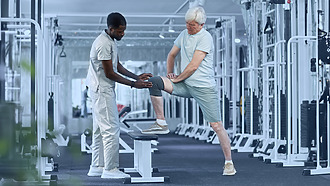
Therapy for osteoarthritis of the knee focuses on relieving pain and preventing the problem from getting worse.
There is no one-size-fits-all cure for osteoarthritis of the knee, and adjusting daily habits is recommended at the start of treatment.
- Patients should avoid activities that aggravate knee pain or swelling (e.g. walking up stairs).
- A modified regimen should include regular exercise to strengthen the knee muscles, balance and coordination of movement. A physiotherapist can best help you choose the right exercises and physical activities.
- If you are overweight, it is advisable to adjust your lifestyle and reduce your weight. The extra kilos are a strain on all the joints.
While the brace cannot treat osteoarthritis in the knee, occasional use of this device will promote stability and ease movement.[14]
Medicaments for osteoarthritis of the knee
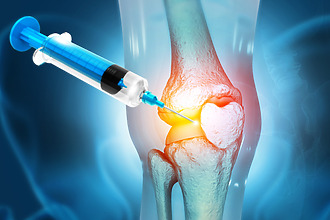
If regimen measures do not bring relief from the symptoms of the disease, it is appropriate to consult a doctor on how to treat osteoarthritis of the knee with medication.
- Over-the-counter painkillers and anti-inflammatory drugs are the initial choice. Caution should be exercised when using them, as they can have side effects if taken for an extended period of time.
- Another category of drugs are coxibs, which belong to the non-steroidal antirheumatic drugs. They relieve pain and inflammation and should have fewer adverse effects in the digestive tract than other anti-inflammatory drugs.
- Corticosteroids in the form of injections, which are injected into the knee, control both pain and inflammation. However, their effect is not permanent and the patient can only receive a limited number of injections.
Local anti-inflammatory drugs in the form of gels, creams or plasters can also help with knee osteoarthritis.[15]

Beware
Treatment for knee osteoarthritis can only be determined by your doctor after considering your overall health. Therefore, do not use this article as a guide to treatment, which can only be determined by a doctor.
Arthritis of the knee - surgery
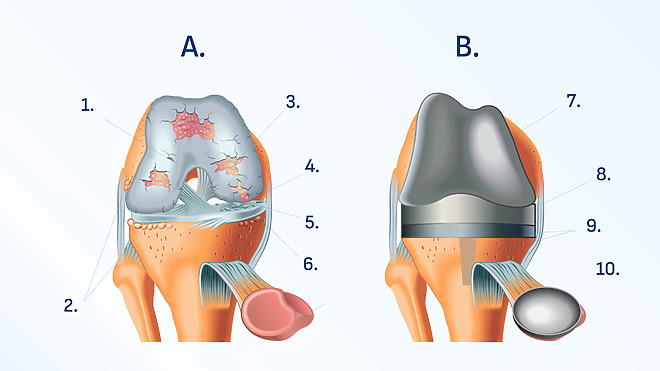
Severe pain that limits the patient’s normal daily activities and a high degree of osteoarthritis may warrant surgical treatment. The type and extent of surgery depends on the condition of the knee joint.
Arthroscopy – an endoscopic (minimally invasive) procedure in which the surgeon examines the knee joint from the inside and may also treat the articular cartilage or other parts of the joint.[16]
Knee replacement – replacement can be partial or total.
In a partial replacement, only the damaged part of the joint is replaced. In total hip arthroplasty (TEP), the lower part of the femur and the upper part of the tibia are replaced with metal material. A polyethylene plate is inserted between these parts to prevent the metal components from rubbing against each other.
After a total knee replacement, there are several measures to follow:
- Postoperative swelling can be relieved by elevated position of the operated limb and cold compresses.
- Any signs of infection (fever, redness, worsening pain at the site of the procedure) should be discussed with your doctor.
- It is not possible to drive a car after the operation. Healing after surgery takes several weeks.
- Modifying the home helps reduce the risk of falling and damaging the new joint. It is recommended to remove loose rugs and use a raised toilet attachment, non-slip shower mats or various dressing and shoe aids.
After surgery, rehabilitation under the guidance of a physiotherapist is necessary.[17]
Alternative and supportive therapies
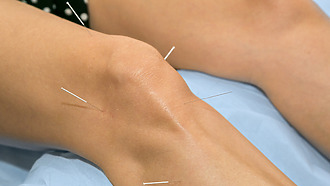
- The use of orthoses, bandages or the application of cold and warm compresses can be considered as additional treatment for osteoarthritis of the knee.
- Acupuncture as an alternative method of pain relief for osteoarthritis uses thin needles that the acupuncturist inserts at various points on the lower limb.[18]
- Taping the knee for osteoarthritis can relieve pain. Taping is usually performed by a physiotherapist, but can also be learned by the patient.[19]
Dietary supplements for osteoarthritis
Glucosamine and chondroitin sulphate are substances that are naturally found in the body and are important for maintaining good joint cartilage health. These two substances can be taken in the form of dietary supplements (called chondroprotectants). They can provide pain relief, but their effect on the repair of damaged cartilage has not been sufficiently proven. [20]Vitamin D may also be an option, as a deficiency of this vitamin may contribute to the development of osteoarthritis.[21]
Prevention and lifestyle in osteoarthritis
Preventing the development of osteoarthritis is mainly based on regular physical activity, which helps maintain a healthy body weight and strengthen the muscles around the joints. How to choose the appropriate sport for osteoarthritis of the knee?
- Activities that do not put excessive strain on the joints (for example, swimming and cycling instead of running or tennis) are suitable.
- The choice of an adequate sport is especially important in cases where patients are already experiencing difficulties and the doctor confirms that the reason is incipient osteoarthritis of the knee.
Orthopaedic aids such as braces or canes provide support, promote stability and facilitate the movement of people with osteoarthritis. Braces are particularly helpful in cases where one side of the knee is affected by osteoarthritis. Walking confidently is also important in preventing falls, which can have other health consequences.[22],[23]
New trends in the treatment of osteoarthritis
New developments in the treatment of osteoarthritis include biological therapy. The patient receives injections of their own stem cells into the affected joint. Thanks to their properties, they have healing potential and promote the recovery of damaged tissue. This treatment is still the subject of clinical trials, in which doctors are investigating the possibilities of stem cells and their effect in the treatment of osteoarthritis.[24]

Important information when dealing with arthritic joints
- Arthritis of the knee is a degenerative disease in which the articular cartilage is damaged.
- Treatment begins with conservative methods such as regimens and painkillers. In the most severe cases, the solution is to replace the knee joint with an artificial implant.
- In the prevention of osteoarthritis, a proper lifestyle is important – regular physical activity, adequate body weight and limiting extreme stress on the joints during work or sports.
Summary and recommendations for the management of knee osteoarthritis
See a doctor
Treatment for osteoarthritis pain is always determined by your doctor based on a general examination, an assessment of your condition and an accurate diagnosis.
Causal treatment of knee osteoarthritis
After a general examination, your doctor will recommend treatment for the cause of your knee osteoarthritis. They will also advise you on possible lifestyle adjustments and the next course of action.
Relieving pain, swelling and inflammation
Symptomatic treatment focuses on the manifestations or signs (symptoms) of the disease. Such treatment can significantly improve your quality of life and support comprehensive treatment during the course of the disease.
Sources, references and literature
[1] Sheth N. P., Foran J. R. H. Arthritis of the Knee. American Academy of Orthopaedic Surgeons, February 2023. Available at: https://orthoinfo.aaos.org/en/diseases–conditions/arthritis-of-the-knee/
[2] Hsu H., Siwiec R. M. Knee Osteoarthritis. StatPearls [Internet]. Treasure Island (FL): StatPearls Publishing; January 2023. Available at: https://www.ncbi.nlm.nih.gov/books/NBK507884/
[3] Sheth N. P., Foran J. R. H. Arthritis of the Knee. American Academy of Orthopaedic Surgeons, February 2023. Available at: https://orthoinfo.aaos.org/en/diseases–conditions/arthritis-of-the-knee/
[4] Sheth N. P., Foran J. R. H. Arthritis of the Knee. American Academy of Orthopaedic Surgeons, February 2023. Available at: https://orthoinfo.aaos.org/en/diseases–conditions/arthritis-of-the-knee/
[5] Hsu H., Siwiec R. M. Knee Osteoarthritis. StatPearls [Internet]. Treasure Island (FL): StatPearls Publishing; January 2023. Available at: https://www.ncbi.nlm.nih.gov/books/NBK507884/
[6] McClelland D. Knee osteoarthritis. Bupa, December 2020. Available at: https://www.bupa.co.uk/health-information/knee-pain/knee-osteoarthritis
[7] Knee Arthritis. Johns Hopkins Medicine. Available at: https://www.hopkinsmedicine.org/health/conditions-and-diseases/knee-arthritis
[8] Knee Arthritis. Johns Hopkins Medicine. Available at: https://www.hopkinsmedicine.org/health/conditions-and-diseases/knee-arthritis
[9] Knee Arthritis. Johns Hopkins Medicine. Available at: https://www.hopkinsmedicine.org/health/conditions-and-diseases/knee-arthritis
[10] Sheth N. P., Foran J. R. H. Arthritis of the Knee. American Academy of Orthopaedic Surgeons, February 2023. Available at: https://orthoinfo.aaos.org/en/diseases–conditions/arthritis-of-the-knee/
[11] WOMAC Osteoarthritis Index. Physiopedia, 2023. Available at: https://www.physio-pedia.com/WOMAC_Osteoarthritis_Index
[12] Holland K. Stages of Osteoarthritis (OA) of the Knee. Healthline, 13. June 2023. Available at: https://www.healthline.com/health/osteoarthritis-stages-of-oa-of-the-knee#stage-0-normal
[13] Hsu H., Siwiec R. M. Knee Osteoarthritis. StatPearls [Internet]. Treasure Island (FL): StatPearls Publishing; January 2023. Available at: https://www.ncbi.nlm.nih.gov/books/NBK507884/
[14] Sheth N. P., Foran J. R. H. Arthritis of the Knee. American Academy of Orthopaedic Surgeons, February 2023. Available at: https://orthoinfo.aaos.org/en/diseases–conditions/arthritis-of-the-knee/
[15] Sheth N. P., Foran J. R. H. Arthritis of the Knee. American Academy of Orthopaedic Surgeons, February 2023. Available at: https://orthoinfo.aaos.org/en/diseases–conditions/arthritis-of-the-knee/
[16] McClelland D. Knee osteoarthritis. Bupa, December 2020. Available at: https://www.bupa.co.uk/health-information/knee-pain/knee-osteoarthritis
[17] Knee Replacement Surgery Procedure. Johns Hopkins Medicine. Available at: https://www.hopkinsmedicine.org/health/treatment-tests-and-therapies/knee-replacement-surgery-procedure
[18] Sheth N. P., Foran J. R. H. Arthritis of the Knee. American Academy of Orthopaedic Surgeons, February 2023. Available at: https://orthoinfo.aaos.org/en/diseases–conditions/arthritis-of-the-knee/
[19] Taping for knee osteoarthritis. Australian Family Physician 2013; 42 (10): 725-726. Available at: https://www.racgp.org.au/afp/2013/october/taping-for-knee-osteoarthritis
[20] Sheth N. P., Foran J. R. H. Arthritis of the Knee. American Academy of Orthopaedic Surgeons, February 2023. Available at: https://orthoinfo.aaos.org/en/diseases–conditions/arthritis-of-the-knee/
[21] Knee Arthritis. Johns Hopkins Medicine. Available at: https://www.hopkinsmedicine.org/health/conditions-and-diseases/knee-arthritis
[22] Holland K. Stages of Osteoarthritis (OA) of the Knee. Healthline, 13. June 2023. Available at: https://www.healthline.com/health/osteoarthritis-stages-of-oa-of-the-knee#stage-0-normal
[23] Sheth N. P., Foran J. R. H. Arthritis of the Knee. American Academy of Orthopaedic Surgeons, February 2023. Available at: https://orthoinfo.aaos.org/en/diseases–conditions/arthritis-of-the-knee/
[24] Sheth N. P., Foran J. R. H. Arthritis of the Knee. American Academy of Orthopaedic Surgeons, February 2023. Available at: https://orthoinfo.aaos.org/en/diseases–conditions/arthritis-of-the-knee/
| Rate this article |
|
|
5/51 Reviewed by
|
How to mitigate pain, swelling and inflammation?
The solution may be symptomatic treatment using pulsed magnetic therapy, which targets symptoms and signs such as pain, swelling and inflammation. In addition, such treatment can support comprehensive treatment and significantly improve quality of life.
Explaining the Effects
The basic principle of Biomag 3D pulsed magnetic therapy (PEMF therapy) is the generation of electromagnetic pulses. These pulses penetrate through the clothing and through the entire depth of the tissue to the point of targeted application. The pulses have specially developed biotropic parameters (e.g. frequency, shape, intensity) to best affect various health problems.
What are the effects of 3D magnetic therapy (PEMF therapy)?
- It helps to relieve pain.
- Anti-inflammatory.
- Supports the control of swelling.
How is the therapy applied?
The application is very simple. Select the desired therapeutic effect on the device and attach the connected applicator to the desired application site. Magnetic therapy is usually applied 2 times a day for 20 minutes.
We will be happy to help you try this method and advise you on which device to purchase.
